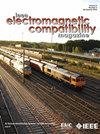Radiated Emission from Superconducting Coplanar Waveguide Transmission Lines
IF 2.5
3区 计算机科学
Q3 ENGINEERING, ELECTRICAL & ELECTRONIC
IEEE Transactions on Electromagnetic Compatibility
Pub Date : 2025-01-22
DOI:10.1109/TEMC.2024.3521863
引用次数: 0
Abstract
Radiation from superconducting transmission lines is an undesirable phenomenon in a superconducting circuit due to the degradation of signal integrity. This reduces the performance of the circuit. While much analysis has been performed on radiated emission in normal circuits, no study has been conducted on superconducting circuits, which are recognized as a new generation of electronic devices. In this article, the radiated emission from superconducting coplanar waveguide (SCPW) transmission lines is investigated. To this end, the current density distribution in the SCPW cross section is required. A procedure is presented in this article through which the current in the ground plane is related to that in the superconducting strip. This is based on the conformal mapping approach. Therefore, by using the current in the strip available in our recently published article, the current in the ground plane and subsequently the electromagnetic radiation from the SCPW can be obtained. The radiation from the SCPW is examined at different temperatures as well as different film thicknesses and different SCPW gaps. Results show that as the temperature increases, the SCPW radiates a lower amount of power. The same behavior is seen for decreasing the SCPW gap. Furthermore, our study reveals that the SCPW with a thinner film radiates a lower amount of power.超导共面波导传输线的辐射发射
在超导电路中,由于信号完整性的降低,超导传输线产生的辐射是一种不理想的现象。这降低了电路的性能。超导电路是公认的新一代电子器件,对其辐射发射进行了大量的分析,而对超导电路的研究却很少。本文研究了超导共面波导(SCPW)传输线的辐射发射。为此,需要得到SCPW截面上的电流密度分布。本文提出了一种使地平面电流与超导带电流相对应的方法。这是基于保角映射方法。因此,利用我们最近发表的文章中提供的条带电流,可以得到接地面上的电流以及随后的SCPW的电磁辐射。研究了在不同温度、不同膜厚和不同缝隙条件下的辐射特性。结果表明,随着温度的升高,SCPW的辐射功率降低。在减少SCPW差距时也可以看到相同的行为。此外,我们的研究表明,薄膜较薄的SCPW辐射的功率较低。
本文章由计算机程序翻译,如有差异,请以英文原文为准。
求助全文
约1分钟内获得全文
求助全文
来源期刊
CiteScore
4.80
自引率
19.00%
发文量
235
审稿时长
2.3 months
期刊介绍:
IEEE Transactions on Electromagnetic Compatibility publishes original and significant contributions related to all disciplines of electromagnetic compatibility (EMC) and relevant methods to predict, assess and prevent electromagnetic interference (EMI) and increase device/product immunity. The scope of the publication includes, but is not limited to Electromagnetic Environments; Interference Control; EMC and EMI Modeling; High Power Electromagnetics; EMC Standards, Methods of EMC Measurements; Computational Electromagnetics and Signal and Power Integrity, as applied or directly related to Electromagnetic Compatibility problems; Transmission Lines; Electrostatic Discharge and Lightning Effects; EMC in Wireless and Optical Technologies; EMC in Printed Circuit Board and System Design.

 求助内容:
求助内容: 应助结果提醒方式:
应助结果提醒方式:


